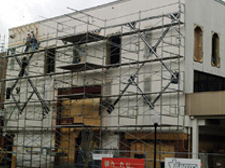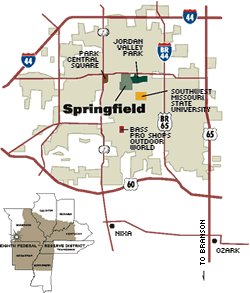Community Profile: Springfield, Mo., Is a Boomtown Once Again
There is history here, some of it bloody. The story goes that in 1865 the legendary gambler and gunfighter "Wild Bill" Hickok shot a man dead in Park Central Square in downtown Springfield, just a few feet from the old Springfield Patriot newspaper building. Supposedly, Hickok outdueled David Tutt after the two had argued over a timepiece.
Steve Warlick gets a kick out of telling that tale about tough men and bloodletting. Warlick is an architect and one of Springfield's energetic new entrepreneurs. He and business partners Aaron Buerge and Rich Branham bought the long-shuttered Patriot building on the cheap in 1999. They converted it into the Trolley Grill, a restaurant that opened in February 2003.
Business is good, Warlick says, but the real estate bargains in Park Central Square are getting hard to find.
"It wasn't long ago that you could get property for $4 a square foot around here," Warlick says. "The going rate now on some properties is about $10 for a square foot. This area is hot."
Buerge, who became somewhat of a national celebrity after starring in one of The Bachelor television programs, adds that, "On a Friday night or a Saturday night, there are people everywhere in the square. The lines are out the door here."
In another part of downtown, cappuccino flows all evening at Mudhouse. The coffee shop draws heavily from Springfield's approximately 40,000 college students. Co-owners Brian King and Rob Weislocher say that downtown Springfield has that energetic feel of a happening place. The boards are coming off buildings. Coffee shops, restaurants and hip retail stores are opening.
The rest of Springfield also is going strong. The Missouri Economic Research and Information Center (MERIC) has reported that Springfield is an "economic engine of Missouri." Springfield accounts for just 3 percent of Missouri's workforce, but the area created one-fourth of all new jobs in the state between March 2002 and March 2003. Kansas City reported a net job loss during that same time, and St. Louis reported just a minimal gain.
According to recent U.S. Bureau of Labor statistics, Springfield's Greene County ranked 21st of 315 urban counties for job growth. The magazine Inc. rates Springfield No. 15 among medium-sized metro areas in the country for doing business. The Springfield metro area has 27 percent more workers than a decade ago.
Springfield does not rely on one big automobile assembly plant or one big steel mill to carry the city's economy. About 92 percent of area businesses employ fewer than 25 workers. Even so, the city has several large employers, such as Bass Pro, MCI, Kraft Foods, 3M, General Electric and Northrup Grumman. CoxHealth and St. John's Health systems employ a total of 16,100 workers.
"When there happens to be a downturn in one sector of the economy, it always seems like the other sectors can pick up the load and carry it for a while," says Greg Williams, senior vice president of economic development for the Springfield Area Chamber of Commerce.
Brian Fogle, the vice president for community development at Springfield-based Great Southern Bank, adds, "We never have the peaks and valleys of other areas that rely on a sole industry."
Besides a diverse economy, Springfield has one of the top tourist attractions in the state. About 4 million people visit the Bass Pro Shops Outdoor World every year to take care of their fishing, hunting and other outdoors needs.
Johnny Morris founded Bass Pro in 1971 as a small space to sell fishing lures at his father's liquor store here. Now, he operates 21 stores across the country, including the 300,000 square-foot main store in Springfield. Some of the unusual features of this store are a 30,000-gallon saltwater aquarium, a waterfall, a firing range and a barber shop.

Downtown's new look harks back to an earlier golden age.
In the 1980s, Springfield's population, like that of many other small cities, grew only slightly. The upsurge started about 1990, and new subdivisions continue to go up all across the southern parts of Springfield, as well as in the nearby communities of Nixa and Ozark.
Some people call this phenomenon "the rural rebound." They credit it to the three R's-retirement, recreation and residential.
"Those three R's are being very kind to Springfield," Fogle says. "The 1990s were a tremendous decade for the Ozarks."
New residents come to Springfield from St. Louis, Kansas City, Chicago and California. They come for the affordable housing, good schools, the rolling Ozark scenery and the chance to catch plenty of large-mouth bass. Just 30 miles away is Branson, one of the entertainment capitals of the country. The magazine Employment Review calls Springfield one of the top 10 places in the United States to work and live.
Williams acknowledges that some longtime residents are angry about the vanishing farmland, about the strip malls and about the traffic snarls during rush hour. He himself laments that it takes him 40 minutes to make the nine-mile commute from his house to the office.
Despite the traffic, he says, "You have a quality of life here that is unequaled in most parts of the country. The News-Leader (newspaper) pointed out in an article in 1996 that 33 percent of the people in this area had been here less than five years. That's a lot of new wealth. Plus, just imagine the energy and synergy that you get from something like that."

Scaffolding and construction crews are common sights downtown.
Back downtown, developers are taking advantage of state and federal historic tax credits, property tax abatement, gap financing and loans of up to $40,000 to make facade improvements. A low-interest loan program, using Community Development Block Grant (CDBG) funds, has provided help for many business people. Since 1997, about $125 million has been invested in Center City, the area that includes downtown and the surrounding urban core.
"In the last few years, the area has started to boom," said Barb Baker, the manager of the Community Improvement District in Springfield. "Now, we're running out of buildings for people to buy."
One of the great success stories downtown is Jordan Valley. The old industrial area was razed and now boasts a 12-acre park featuring fountains, walking paths and an amphitheater. Jordan Valley Ice Park has two hockey rinks.

Hammons Field, the new home of the Southwest Missouri State University Bears.
Across the street from the rinks, baseball fans can see the Southwest Missouri State University Bears play at Hammons Field. The privately developed ballpark opened this spring at a cost of $32 million. The Bears drew an average of 5,206 fans per game this year. The 2003 team drew an average of 1,019 fans. Developers hope to attract a Double-A minor league baseball team to Hammons Field for the 2005 season.
Using state tax credits, the city is converting an old tobacco warehouse and dairy plant into the Creamery Arts Center. The Discovery Center children's museum is undergoing a major expansion thanks to a $2.6 million federal appropriation. The city and SMSU hope to get state and federal grants to turn an old mill into an incubator for businesses involved in such things as advanced manufacturing, bio-systems software engineering and nanotechnologies.
Fogle credits Vision 20/20 for getting the redevelopment process going. Residents and city officials participated in the long-range planning program, which was started by the city and business leaders in the mid-1990s to rebuild Center City. Thanks in part to Vision 20/20, voters passed a hotel/motel tax in 1998 to fund projects such as the ice rinks.
"Vision 20/20 was the chief catalyst for our redevelopment," Fogle says. "That really took us to another level. Back in the late '70s, there was nothing going on in downtown. We've had an energetic group of developers willing to take risk. Now, we're about out of space.
"We talk a lot about the '50s being the golden era for Springfield," Fogle adds. "That was a time of tremendous economic growth. We got Kraft and Zenith and GE to come to our city. Now, there are several of us who've talked about these times being the second golden age of Springfield."

| Springfield, Mo., By The Numbers |
|
|---|---|
| Population | |
| City | 151,010 (2002) |
| Greene County | 241,713 (2001) |
| Labor Force | |
| City | 89,108 (March 2004) |
| County | 133,707 (March 2004) |
| Unemployment Rate | |
| City | 3.8 (March 2004) |
| County | 3.4 (March 2004) |
| Per Capita Personal Income | |
| City | 17,711 (2000) |
| County | 19,185 (2000) |
| Top Five Employers | |
| CoxHealth | 8,600 |
| St. John's | 7,500 |
| SMSU | 3,310 |
| Wal-Mart stores | 3,270 |
| Public schools | 3,200 |
Views expressed in Regional Economist are not necessarily those of the St. Louis Fed or Federal Reserve System.
For the latest insights from our economists and other St. Louis Fed experts, visit On the Economy and subscribe.
Email Us

